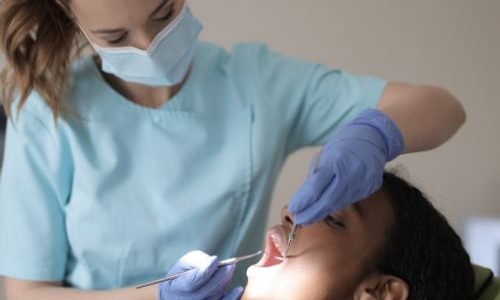Dental Cleaning (Scaling & Polishing)
Scaling and polishing is cleaning of the teeth carried out by a dentist. The dentist will clean around the gum line on the back and front of your teeth to remove any plaque and tartar. The most important and valuable dental visit for you is a dental clean and check-up. Teeth cleaning and polishing allows the dentist to maintain your oral hygiene and health. Regular dental cleaning and checkups are important to prevent dental diseases from developing. Daily brushing, rinsing with antiseptic mouthwash and flossing might not be enough to maintain a good oral health in the long run. To maintain good oral health, it is imperative to visit your dentist every six months. Going for regular check-ups helps keep your gums and teeth healthy and allows early detection of any problems such as gum disease, cavities and oral cancer.

Why is dental cleaning done?
Your teeth are continually bathed in saliva which contains calcium and other substances which help strengthen and protect the teeth. While this is a good thing, it also means that there is a build-up of calcium deposits on the teeth. This chalky substance called calculus or tartar will eventually build up over time. Usually it is tooth coloured and can easily be mistaken as part of the teeth, but it also can vary from brown to black in colour.
If the the calculus (tartar) is allowed to accumulate on the teeth it will provide the right conditions for bacteria to thrive next to the gums. The purpose of the cleaning and polishing is basically to leave the surfaces of the teeth clean and smooth so that bacteria are unable to stick to them and you have a better chance of keeping the teeth clean during your regular home care.
Also it leaves your teeth feeling lovely and smooth and clean, other reasons are:
- To remove stains caused by food for example: coffee, tea, red wine or from smoking.
- To allow screening for oral disease or any systemic disease that may be having an oral manifestation.
- To learn about how best to keep your teeth and gums clean and healthy: the dentist will observe your general dental hygiene during a check up and if it is below satisfactory level the dentist will teach you effective tooth brushing methods.
What to expect ?
Scaling
Commonly used first is an ultrasonic instrument which uses vibrations to knock larger pieces of tartar loose. It also sprays a cooling mist of water while it works to wash away debris and keep the area at a proper temperature. The device emits a humming or high pitched whistling sound. This may seem louder than it actually is because the sound may get amplified inside your head, just like when you put an electric toothbrush into your mouth.The ultrasonic instrument tips are curved and rounded and are always kept in motion around the teeth. They are not sharp since their purpose is to knock tartar loose and not to cut into the teeth. With larger deposits that have hardened on, it can take a longer time to remove these, so your cleaning may take longer.
Polishing
Polishing is usually carried out after scaling to remove stains and make your teeth feel smooth and shiny. Polishing is done with a soft rubber cup that spins. Prophylaxis paste — a special toothpaste-like material is scooped up into the cup and spun around on the teeth. Alternatively prophyjet polishing uses a pressurised spray of air and water with sodium hydrogen-carbonate powder to remove stains, plaque and soft debris from your teeth. It may taste slightly salty.
Fluoride
Your dentist may also apply fluoride. This is the final part of the dental cleaning.This in-office fluoride treatment is meant for topical use only on the surfaces of the teeth and swallowing excessive amounts can give a person a tummy ache as it is not meant to be ingested.Fluoride foam or gel is then placed into small, flexible foam trays and placed over the teeth for 30 seconds. Afterwards the patient is directed to spit as much out as possible into a saliva ejector. The fluoride helps to strengthen the teeth since the acids from bacteria in dental tartar and plaque will have weakened the surfaces. It is advisable not to eat, drink or rinse for 30 minutes after the fluoride has been applied.
Is it painful?
Most people find that cleanings are painless, and find the sensations as tickling vibrations, the cooling mist of water, and the feeling of pressure during scraping do not cause discomfort. There may be a few uncomfortable sensations, but many people don’t mind as they only last a few seconds.Be sure to let your dentist know if you find that you are getting too uncomfortable.
They can recommend various options to make the cleaning more pleasant.Painful cleaning experiences can be caused by a number of things: exposed dentine (not dangerous, but can make cleanings unpleasant), or sore gums.Regular dental teeth cleaning and polishing is the cornerstone for a lifetime of dental health and the best insurance you can have for keeping a healthy and attractive smile!









